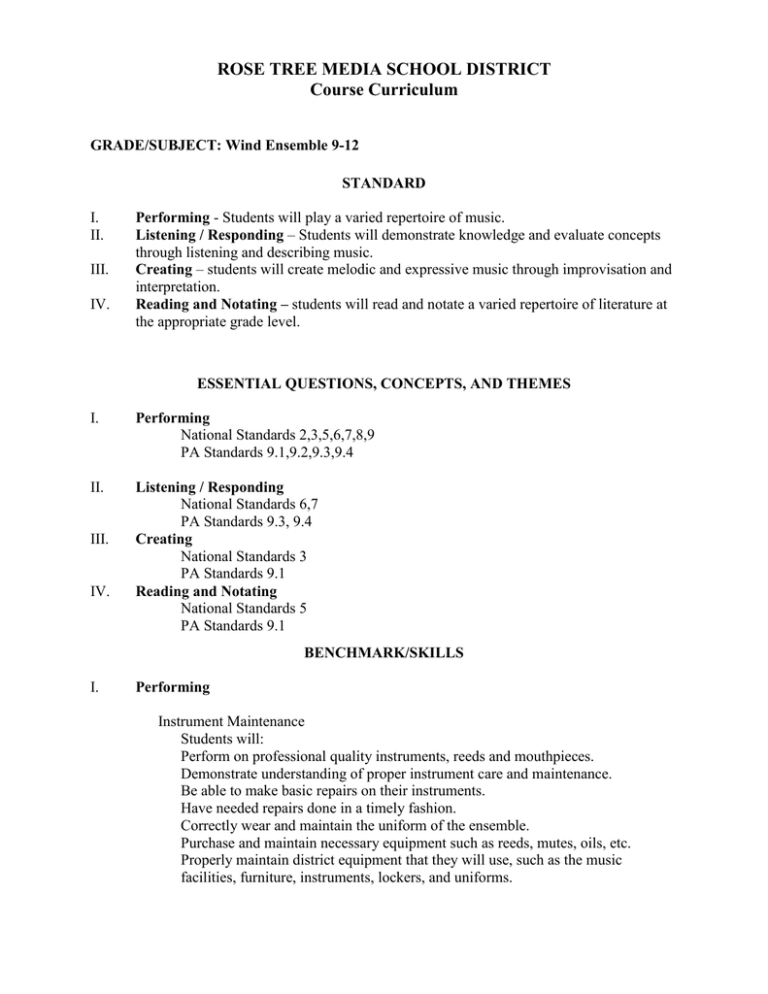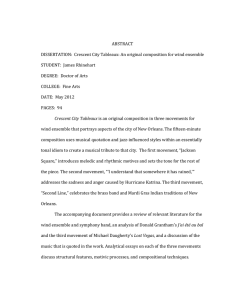ROSE TREE MEDIA SCHOOL DISTRICT Course Curriculum
advertisement

ROSE TREE MEDIA SCHOOL DISTRICT Course Curriculum GRADE/SUBJECT: Wind Ensemble 9-12 STANDARD I. II. III. IV. Performing - Students will play a varied repertoire of music. Listening / Responding – Students will demonstrate knowledge and evaluate concepts through listening and describing music. Creating – students will create melodic and expressive music through improvisation and interpretation. Reading and Notating – students will read and notate a varied repertoire of literature at the appropriate grade level. ESSENTIAL QUESTIONS, CONCEPTS, AND THEMES I. Performing National Standards 2,3,5,6,7,8,9 PA Standards 9.1,9.2,9.3,9.4 II. Listening / Responding National Standards 6,7 PA Standards 9.3, 9.4 Creating National Standards 3 PA Standards 9.1 Reading and Notating National Standards 5 PA Standards 9.1 III. IV. BENCHMARK/SKILLS I. Performing Instrument Maintenance Students will: Perform on professional quality instruments, reeds and mouthpieces. Demonstrate understanding of proper instrument care and maintenance. Be able to make basic repairs on their instruments. Have needed repairs done in a timely fashion. Correctly wear and maintain the uniform of the ensemble. Purchase and maintain necessary equipment such as reeds, mutes, oils, etc. Properly maintain district equipment that they will use, such as the music facilities, furniture, instruments, lockers, and uniforms. Tone Production Students will: Produce a full tone throughout their comfortable register, at a variety of tempos and dynamic levels. Utilize professional level equipment that will enable characteristic tone production. Demonstrate appropriate playing posture for their instrument. Utilize correct and productive breathing technique as appropriate for full tone production. Expand their ranges as appropriate (concert key): Tpt, Bar, Trb F-Bb 2 ½ octaves Tuba F-F 2 octaves Fr. Horn C-F 2 ½ octaves Flute C-C 3 octaves Clarinet D-F 3+ octaves Alto and Bari Sax Db-Ab 2 ½ octaves Tenor Sax Ab – Eb 2 ½ octaves Oboe Bb – D 2 + octaves Bassoon Bb – F 2 ½ octaves Percussion N.R.D.A. Rudiments 1-14 Develop and incorporate and embochure capable of producing consistent and characteristic tone quality throughout the above ranges, while allowing improvement in range, technique, tone, endurance, and articulation. Demonstrate control of a rhythmic vibrato with a consistent embochure when characteristically appropriate. Technique Development Students will: Demonstrate increasing proficiency in the areas of fingerings and rudiments. Perform with proper hand position and posture. Perform the following articulations when directed by the score or the conductor: staccato, legato, marcato, accents, szforzando, forte piano, tenuto, and breath attacks. Perform major scales in all 12 keys, 2 octaves when possible, and 2 octave chromatic scale from memory at mm. = 120. Perform selected minor, pentatonic, blues and synthetic scales at mm.= 120 Perform selected repertoire with consistent tempo and accurate pitch. Perform dynamic markings from ppp-fff when directed by the score or conductor. Intonation Students will: Recognize a tone as sharp, flat or in tune upon comparing it with another tone. Tune their instrument to a tuner or to another instrument Correct intonation problems through breath, posture and embochure adjustment. Recognize and adjust to the intonation tendencies unique to their instrument. Purchase and be able to use a tuner. Ensemble Responsibilities Students will: Demonstrate an understanding of their role in the ensemble through their attendance, participation and preparedness. Demonstrate significant conductor awareness and responsiveness. Demonstrate signifincant awareness and ability in the areas of blend, balance, and intonation. Demonstrate understanding of their musical contributions to the ensemble through regular and productive practice. Further their musical abilities and interests through participation in small ensembles, private lessons, and outside performing organizations. Demonstrate understanding of their commitment to the ensemble through punctuality, preparedness, and proper rehearsal and concert etiquette. Demonstrate understanding of their role as an ambassador of their ensemble, school, district and community through their performance, participation, and appearance. Repertoire Students will: Perform repertoire from a variety of cultures, styles, and time periods. Perform solo, small ensemble and large ensemble repertoire. Perform a variety of scales, warm-ups and technical exercises. Purchase solo works, methods and collections of their choosing, or as suggested by music professionals, for personal use. Perform from the PMEA District Band Audition solo repertoire. II. Listening and Responding Individual Skills Students will: Evaluate their own and others’ tone quality and playing ability based on what is characteristic of their instrument at the appropriate level. Describe their own and others’ tone and ability using proper music terminology. Judge their own and others’ playing in terms of aesthetics. Distinguish between melody and harmony. Identify familiar rhythm patterns aurally. Identify instruments according to their timbre. Recognize various musical styles and stylistic periods aurally. Recognize major works and composers from band and symphonic literature. Perform at appropriate dynamic levels Evaluate varying levels of musicianship upon hearing a performance or recording of a performance Demonstrate increasing appreciation of “art music:” symphonic, orchestral, jazz, musicals, ballet, and opera. Ensemble Skills Students will: Demonstrate their understanding of blend, balance, and intonation. Evaluate the overall sound and technical ability of their ensemble. Evaluate the ensemble’s aesthetic effectiveness in performance. Make musical decisions and adjustments based on their part in a work, and that part’s role in the ensemble. III. Creating Students will: Demonstrate increasing understanding of musical interpretation as it applies to articulation, dynamics, phrasing, expressiveness and emotional content. Explain their interpretation of music performed. Base their interpretations on knowledge of historical and stylistic considerations. Compose, arrange, and improvise music as appropriate to their abilities. Discuss elements of composition such as: diminution, augmentation, variation, modulation, orchestration, sequence, and countermelody. Perform different arrangements of the same composition and discuss the options available to arrangers. IV. Reading and Notating Students will: Sight read music at a difficulty level of III on a scale of I-VI. Perform music at grade levels III-VI as appropriate. Perform according to the given notation of pitch and rhythm accurately. Perform according to the given notation including: tempo, style, articulation, and dynamic markings. Perform according to and be able to define standard expressive terminology. _____________________________________________________________________________ PRODUCTS, PERFORMANCES, ASSESSMENTS Individual performance evaluations in sectional Ensemble performance evaluations in rehearsal Concert performances Solo and small ensemble performances Individual playing exams Teacher observation of daily participation Self evaluation Written reviews of live musical performances Inspection of the equipment the student is responsible for Attendance records Student feedback LEARNING ACTIVITIES/INSTRUCTIONAL STRATEGIES I. Performing Performing alone and with others on a variety of instruments Teacher modeling Peer coaching and feedback Classroom discussion Repertoire exploration Music analysis Use of appropriate tone and technical exercises and repertoire II. Listening and Responding Directed listening Critical listening and evaluation Modeling through use of recordings of fine ensembles. Classroom discussion Making value judgements III. Creating Experimentation with musical elements (pitch, duration, timbre, intensity) Exploration of chord / scale theory and relationships Experimentation with musical expression, emotion, and meaning IV. Reading and Notating Teacher modeling Sight reading Identification of familiar patterns of pitch and rhythm Generalization of knowledge and application to unfamiliar patterns. ADAPTATIONS/INCLUSION TECHNIQUES Adaptations as stated in student’s IEP Changing instruments to meet student’s needs while maintaining ensemble integrity Adapting music to meet student’s needs while maintaining ensemble integrity Adapting schedule to meet student’s needs while maintaining ensemble integrity REMEDIATION STRATEGIES Assigning students to appropriate ensembles and parts based on difficulty and ability Individualization Private lessons instruction Assigning students to different instruments as appropriate and beneficial to the individual and the ensemble. ENRICHMENT STRATEGIES Assigning students to appropriate ensembles and parts based on difficulty and ability Private lessons instruction Level One options for qualified students Auditions for additional ensembles such as PMEA, and bands and orchestras outside of what the school offers. Leadership opportunities: Drum Major, Section Leader, Principal Player Creation of and participation in additional ensembles: Flute Ensemble, Percussion Ensemble, etc. Ensemble participation in local and national contests and festivals MATERIALS/RESOURCES/TECHNOLOGY Band Literature Grades III-VI in difficulty consisting of standard concert band repertoire as outlined by state and national festival lists, ABA and NBA suggested lists, and other reputable sources. Instruments Student Owned or Rented – professional quality instrument District Supplied: Bassoon, Bass Clarinet, Tenor Saxophone, Baritone Saxophone, French horn, Baritone, Tuba, Percussion Music notation software Finale Finale Notepad Scales Major, minor and chromatic scales Other scales such as pentatonic or blues when appropriate Area music teachers and Community members Circle of 4ths Method books Symphonic Warmups for Band by Claude Smith The Rehearsal Handbook by Frank Battisti 66 Festive and Famous Chorales compiled by Frank Erickson Local performances Chorales Internet Student projects Small ensemble music Solos Audio and video recordings Recording technology INTERDISCIPLINARY CONNECTIONS/MULTICULTURAL STRANDS Language Arts Music as a language of expression and emotion Reading and comprehension of symbols which represent sound Art The interpretation of music as an art form Connections between music and other art forms Physical Education Kinesthetic intelligence, large and small motor coordination Cardio and strength training (marching band) Social Studies Music as it relates to time periods and cultures The effects of music on culture and vice versa Historical perspectives Appreciation of musical diversity Math Subdivisions of rhythm and meter Ratios of note values Science Physics of acoustics Properties of sound waves and vibration Notation as a graph of pitch and duration Multicultural Connections See “Social Studies”




